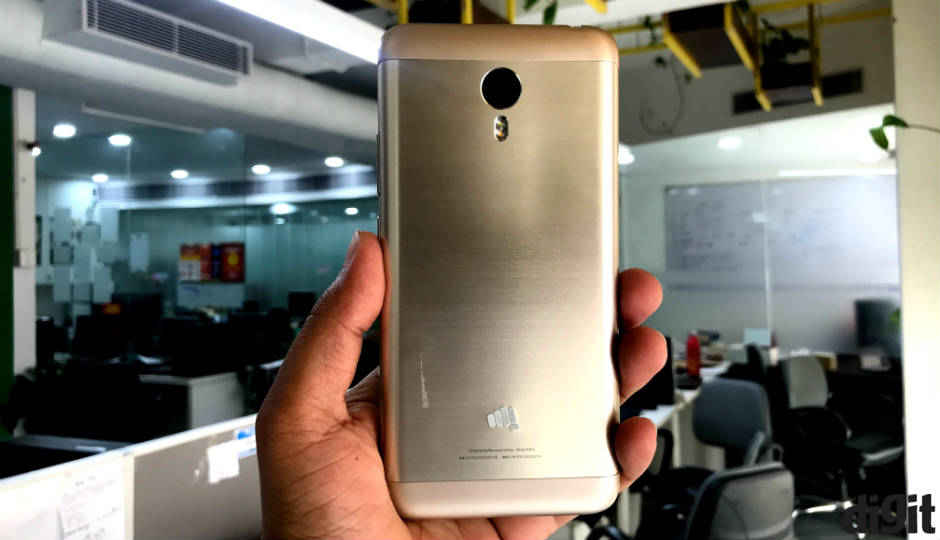Micromax Evok Note First Impressions: Inexpensive, but could be better

Micromax is taking a shot at the online market, but the Evok Note is not the best way to begin.
Historically, Micromax has been a quintessential Indian brand. It sells phones offline, in markets that most tier I consumers only ever read about. However, the influx of Chinese OEMs like Oppo and Vivo has affected Micromax’s rule in that segment, making the company rethink its strategy. This, comes in the form of a tie-up with Flipkart, where Micromax will use the company’s insights about the online market to make new smartphones. The first of these is the Micromax Evok Note.
Selling exclusively on Flipkart, the phone costs Rs. 9,499 and looks almost exactly like the Xiaomi Redmi Note 3 (review). It runs on a MediaTek MT6753 SoC, clocked at 1.3GHz and has 3GB of RAM. There’s also 32GB of onboard storage, while a 64GB variant is expected later. There’s a 13MP camera on the back and a 5MP camera on the front, and a 5.5 inch FHD display panel. This is all driven by a 3950 mAh battery, which Micromax says is the hero of the device.
Performance
The choice of SoC is interesting. It brings to the fore the fact that Micromax wanted an FHD panel on this device. This, perhaps is a direct impact of Flipkart’s customer insights. The MediaTek MT6753 supports FHD panels at best, and provides an ideal cost scenario for companies. However, one can’t help but wonder why a Snapdragon 430 was not chosen.
Nevertheless, the phone feels sluggish on initial impressions. The same is evident from benchmark scores as well, however, we’re yet to complete our portfolio of tests on the smartphone. In essence, though, you do see lags on the smartphone. For example, clearing apps using the button built into the UI results in a split second freeze. We have also noticed slight frame drops when moving from app-to-app.
Interestingly, this is one of the few Micromax smartphones that runs on Yu’s (Micromax’s sister brand) Around platform. The Android on Steroids launcher is on the device, and therein lies a big problem. Micromax has essentially downloaded the launcher onto the smartphone, thereby adding overheads on the processor, at least theoretically. Where UIs today are always stitched into the OS, AOS here runs as a launcher instead of UI. In the long run, this should mean more memory consumption and it’ll tax the processor.
Android on Steroids
Before we begin with the AOS launcher on this smartphone, we must mention that is runs on Android Marshmallow. This, in our opinion is a disappointing choice. Given that Google is already prepping the launch of Android O, it’s about time even the cheapest smartphones in the market come with Android Nougat. Micromax, though, isn’t the only offender in this regard. Almost none of the sub-15k smartphones run on Android Nougat, which gives Motorola’s smartphones a major edge.
While we’re on the topic, Android on Steroids does add the Around app to this device. With that, you get an additional screen, that integrates apps like Uber, shopping apps and more. It’s a nifty little feature on paper, allowing easy access to apps that many of us use regularly. However, the fact that Uber, Amazon and more are pre-installed on the smartphone kind of breaks the whole idea of Around. One wonders why the apps are pre-installed too, since uninstalling Uber still showed nearby cabs from the app on the Around screen. To use Around services, you’ll need to create a Micromax Account.
The UI largely looks the same as stock Android, but there are quite a few pre-loaded apps on the device. Thankfully, most of these can be uninstalled, while others can be disabled if you don’t need them. Since the phone has 32GB of inbuilt storage, this doesn’t particularly come in the way of using the phone. However, this being an Android phone, we’d recommend uninstalling the apps you don’t use, since they will make the device slower in the long run.
Also, the fact that Steroid Launcher has simply been installed on top of the OS is quite evident and the integration is far from seamless. For instance, on the Evoke Note, you get the Google Search bar (which cannot be removed), while there’s an added Search bar from Steroid launcher below it. Similarly, the Evok Power has a quick settings toggle pulled from the top and an iOS Control Centre like toggle that comes out from the bottom. Both accomplish exactly the same task. Moreover, Micromax has replaced the Gallery app with its own version and quite frustratingly, even the Gallery app popped a video ad without any intimation.
Unlike the Chinese OEMs, you do get an app drawer on this device, which scrolls vertically with apps arranged in alphabetical order. You also get a search menu within the app drawer itself.
There’s also a Secure Vault feature, carried over from the Micromax Dual 5. Of course, this one isn’t as powerful as that device, but it allows some level of privacy. You can put sensitive photos, videos and even hide apps using this launcher. It is accessed by tapping the fingerprint sensor when the phone is unlocked and only a registered fingerprint will be allowed to enter it.
While Secure Vault is indeed a commendable implementation, overall, the UI leaves you somewhat disappointed, at least on first impressions. The launcher integration is far from seamless and the overall usage experience hasn’t been the best we’ve seen so far.
Display
On paper, a 5.5 inch FHD display is actually a good spec to offer at the sub-10k price point. Flipkart’s filters show there’s no smartphone on the website offering the same. Usually, you either get smaller screen sizes or lower resolution at this price. Nevertheless, this isn’t a first since Xiaomi’s Redmi Note 4 (review) has offered such a display at the price.
Specs aside, the display is actually reasonable as far as colours are concerned. Touch response is smooth and we haven’t found any missed touches so far. However, colour saturation isn’t the best, meaning colours don’t particularly pop on this panel. So, even high resolution images do look somewhat subdued.
Overall, it seems like a reasonable display panel, but we wouldn’t have you expecting a bright and colourful display as the spec may suggest.
Battery and Camera
As far as first impressions are concerned, the Micromax Evok Note isn’t the most impressive out there. However, a lot can change with a good display and camera. We haven’t had the chance to test these two yet, but a 3950 mAh battery should be no slouch.
We will also be testing the 13MP camera soon enough, which is another spec that Micromax has matched. Initial shots suggest that the sensor is weaker than phones like the Moto G5, and images seem sub-par in terms of details. However, a thorough test is wanted right now.
To conclude…
The Micromax Evok Note is a first for the company. It’s an effort at building a brand that is meant to be online only, and Flipkart’s insights can indeed be helpful. However, the online market is a different beast altogether. Consumers here do have myriad choices and companies like Huawei, Xiaomi or Motorola are as difficult to compete against as Oppo or Vivo. From our first impressions of the Evok Note, it seems Micromax will have to raise its game if it is to gain a fair share of this market.








